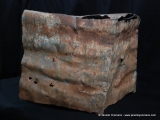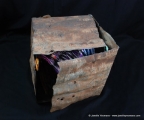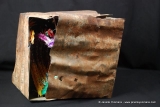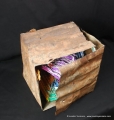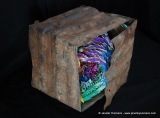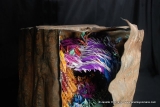Corrugated iron, Tupperware brochures, found object, wire.
43 x 35 x 31cm
In this sculpture, the idea of inner beauty is contrasted with what we see on the outside, which is only skin deep. Corrugated iron was chosen to form a box, as this material has a history of external use and speaks ‘houses’, so it easily represents the idea of human body as home to spirit, emotions, thoughts and attitudes, which are portrayed in the interior. I chose the rustiest and most holey piece I could find to give the idea that our body is something that wastes away, and also that it may not be nice to look at.
In contrast, I wanted the inside to look beautiful and represent inner beauty, which led me to fold 1000 origami cranes, as the crane has traditionally been associated with purity, fidelity, honesty, loyalty, nobility, beauty, honour and longevity and is known as “the bird of happiness”. With the story of Sadako Sasaki, cranes have also become a symbol of world peace, and it is said that if a person folds 1000 of them, their wish comes true. I have used pages from old Tupperware catalogues to fold the cranes in keeping with the idea of the interior of home, and it also suggests that what is destined for the bin can be made beautiful.
The cranes are strung as hearts, suggesting that it is our heart attitude that really matters. While I was making this sculpture, I unwittingly brought home a ‘treasure’ from the local op shop which I had popped in my ‘Fill a bag for $3’ bag. Funnily enough, I had been ‘easily fooled’ by the little brown vase, as it wasn’t until I washed it that I noticed: 1. That it was made in Japan; 2. That it had a crane on it; and 3. That the crane was inside a heart! It was perfect to hold some crane ‘flowers’ that are threatening to spill out of the box.
Late in 2009 I was asked to exhibit the work and put the item on a particular plinth which happened to have some people leaning on it. I politely asked if they could move so I could put my sculpture there, which they kindly did, however one of them asked the question which had so quickly come to mind, “Is that worth putting on there?!”. I responded carefully by saying “It doesn’t matter what it looks like on the outside, it’s what’s on the inside that matters.” The person was quick to move away with no attempt to take a second look or to find out what was on the inside. They had been easily fooled!
Easily Fooled suggests that people are quick to judge by what they physically see, but if they take time to get to know the person, they may truly find a treasure within.
